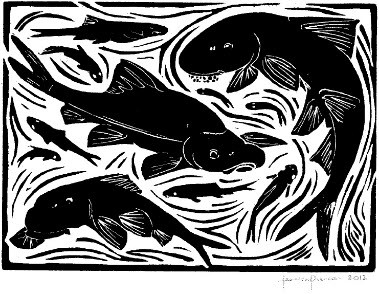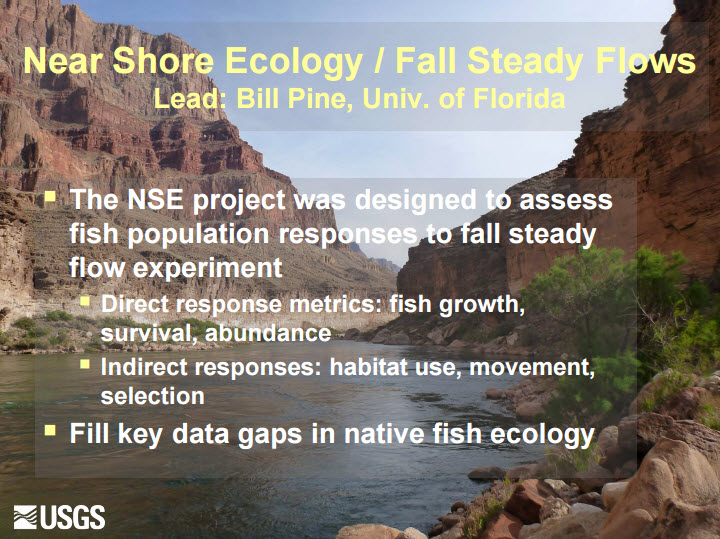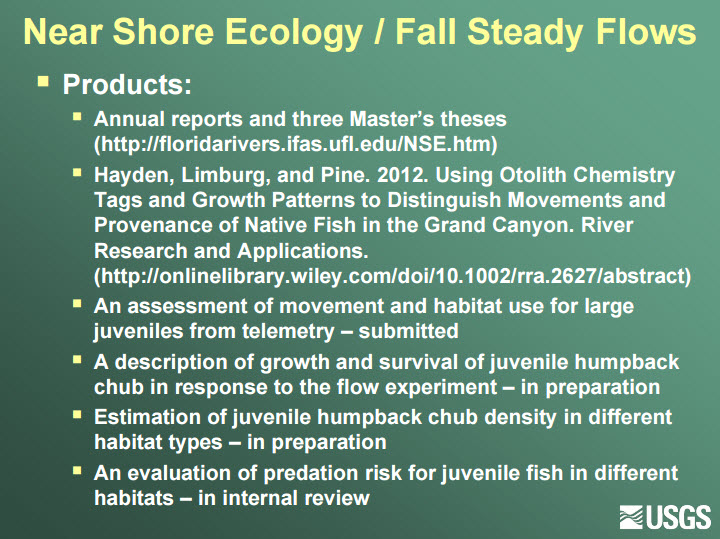Difference between revisions of "Near Shore Ecology (NSE) Study"
Cellsworth (Talk | contribs) |
Cellsworth (Talk | contribs) |
||
| Line 119: | Line 119: | ||
The NSE project developed a sampling and analytical framework to directly assess juvenile humpback chub population responses to management actions at smaller fish sizes than were previously possible. This framework is important, as the key outcome from many different types of management actions in the Colorado River is to improve survival of juvenile humpback chub, increasing overall abundance and accelerating the population to recovery. The NSE project also documented that '''small juvenile humpback chub can survive and rear in the mainstem Colorado River'''. This information is important because adult humpback chub numbers (age 4+) have increased over the past decade, possibly due to improved survival in the mainstem Colorado River (Coggins and Walters 2009). | The NSE project developed a sampling and analytical framework to directly assess juvenile humpback chub population responses to management actions at smaller fish sizes than were previously possible. This framework is important, as the key outcome from many different types of management actions in the Colorado River is to improve survival of juvenile humpback chub, increasing overall abundance and accelerating the population to recovery. The NSE project also documented that '''small juvenile humpback chub can survive and rear in the mainstem Colorado River'''. This information is important because adult humpback chub numbers (age 4+) have increased over the past decade, possibly due to improved survival in the mainstem Colorado River (Coggins and Walters 2009). | ||
| − | We identified chemical markers that can distinguish fish use of Little Colorado River from mainstem use. Humpback chub in this reach of Grand Canyon originate overwhelmingly from the Little Colorado. Mainstem adult otoliths showed evidence that longer rearing in the Little Colorado promotes better growth and recruitment. The combination of otolith chemistry and growth increment analysis together produced a good natural marker that could be used as a tag to follow fish movements between the mainstem and Little Colorado River. Further work will be needed to extend this methodology to other humpback chub aggregations within Grand Canyon and possibly to other native fish species assessments. | + | We identified '''chemical markers that can distinguish fish use of Little Colorado River''' from mainstem use. Humpback chub in this reach of Grand Canyon originate overwhelmingly from the Little Colorado. Mainstem adult otoliths showed evidence that longer rearing in the Little Colorado promotes better growth and recruitment. The combination of otolith chemistry and growth increment analysis together produced a good natural marker that could be used as a tag to follow fish movements between the mainstem and Little Colorado River. Further work will be needed to extend this methodology to other humpback chub aggregations within Grand Canyon and possibly to other native fish species assessments. |
The results of the NSE project suggest that '''juvenile humpback chub survival, growth, abundance, and habitat use are robust (did not change) to the fall steady flows observed during 2009-2011'''. It is likely that more extreme flow treatments (e.g. higher or lower discharges, longer duration) are required before changes in these metrics would be observed. This research demonstrates the apparent flexibility of juvenile humpback chub in habitat selection regardless of fluctuating or steady river flows. Our development and application of methods to assess the growth, survival, and persistence of juvenile humpback chub in the mainstem Colorado River are key new additions to the body of knowledge available for managing the Colorado River and understanding how juvenile fish populations respond to hydropower operations in regulated rivers globally. | The results of the NSE project suggest that '''juvenile humpback chub survival, growth, abundance, and habitat use are robust (did not change) to the fall steady flows observed during 2009-2011'''. It is likely that more extreme flow treatments (e.g. higher or lower discharges, longer duration) are required before changes in these metrics would be observed. This research demonstrates the apparent flexibility of juvenile humpback chub in habitat selection regardless of fluctuating or steady river flows. Our development and application of methods to assess the growth, survival, and persistence of juvenile humpback chub in the mainstem Colorado River are key new additions to the body of knowledge available for managing the Colorado River and understanding how juvenile fish populations respond to hydropower operations in regulated rivers globally. | ||
Revision as of 15:49, 27 September 2016
|
|
Introduction- Management actions in aquatic ecosystems are frequently directed at restoring or improving specific habitats to improve fish growth and survival. In the Grand Canyon reach of the Colorado River experimental flow operations as part of the Glen Canyon Dam Adaptive Management Program impact the creation of habitat types (i.e., sandbars and associated backwaters), water temperatures, or flow fluctuations and magnitude which are critical for juvenile native fish conservation. One of the objectives of a recent experiment evaluating steady flow operations from Glen Canyon Dam was to understand how river discharge, through its interaction with physical habitat structure, influences the growth, survival rates, and habitat use of juvenile native fish in the Colorado River in Grand Canyon. The key fish species of interest was humpback chub Gila cypha, currently listed as “Endangered” under the US Endangered Species Act. Population recovery of humpback chub is of keen interest to numerous federal, state, and tribal entities. The “Nearshore Ecology” (NSE) project was designed to address key fundamental research questions to improve our knowledge of humpback chub population ecology.
|
| -- | -- | -- |
|---|
|
|



